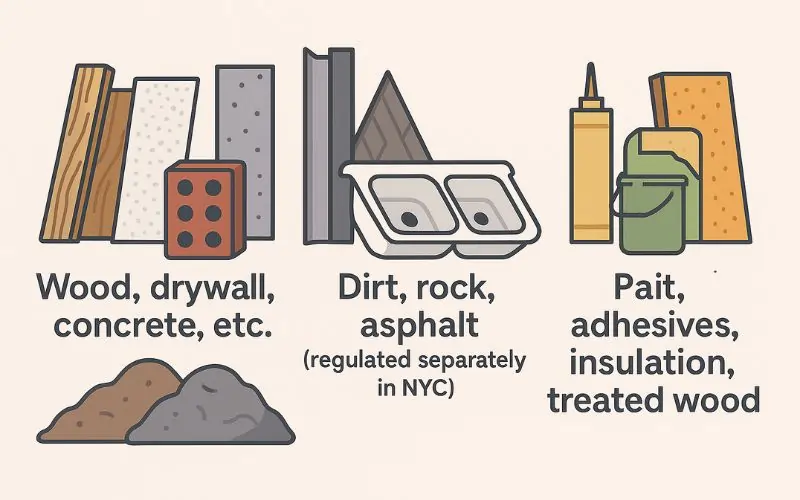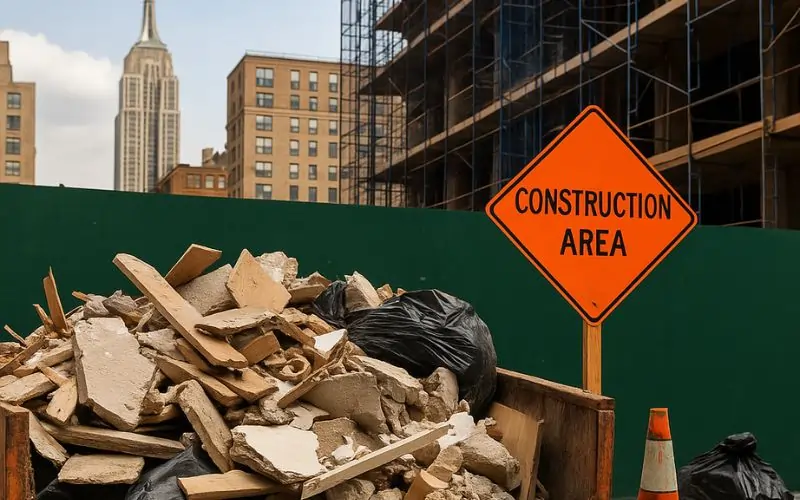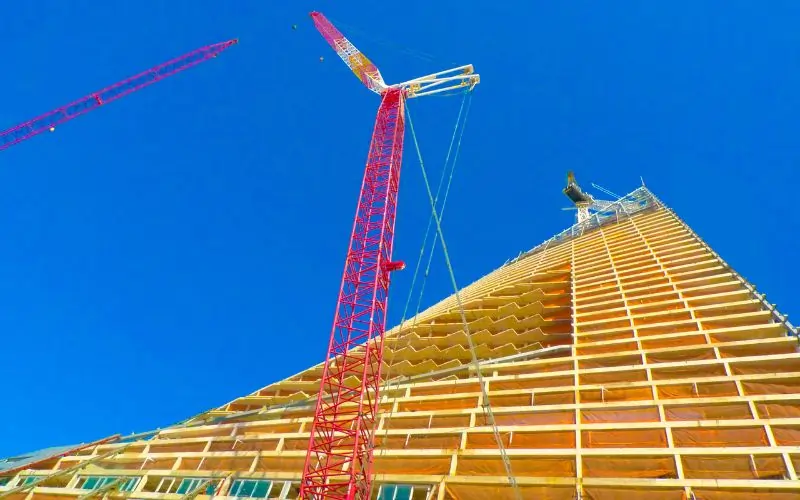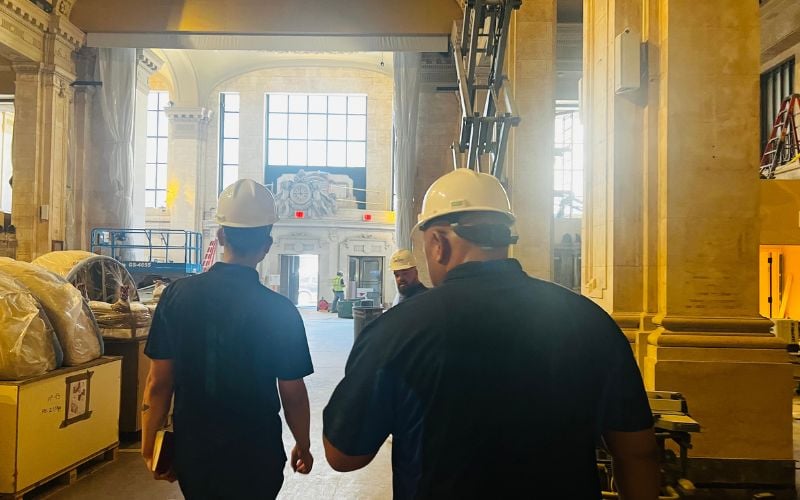Avoid violations and job site delays. Learn the NYC and NY State construction waste disposal rules every project manager needs to know—permits, penalties, and legal dump sites included.
You’re Not Too Busy to Get Fined
If you’re a project manager or General contractor running construction sites in New York, New Jersey, or Connecticut, you already know the chaos of the final construction phase. Punch lists, trades, inspections—all eyes on the finish line. But if you’re cutting corners on construction waste disposal, you’re setting yourself up for fines, stop-work orders, or worse, not completing the Certificate of Occupancy.
Maintaining compliance with construction waste disposal regulations is crucial not only for avoiding penalties but also for upholding your reputation and trust with clients.
This guide cuts through the vague language and gives you the clear truth about construction debris regulations in NYC and New York State. If you want to pass inspection and avoid violations, read on.
Who Regulates Construction Waste in NYC and NY State?
You’re dealing with multiple layers of regulation. Here’s who you answer to:
- NYC Department of Sanitation (DSNY): Regulates removal and transport within city limits.
- NYS Department of Environmental Conservation (DEC): Controls what can go where, especially hazardous materials.
- NYC Department of Buildings (DOB): Enforces jobsite compliance during inspections.
- EPA: Kicks in when you’re dealing with asbestos, lead, or hazardous waste.
Project managers are often required to submit permit applications, registration forms, and annual reports to these regulatory agencies to ensure compliance.
Source: NYC DSNY Construction Debris, NYS DEC Solid Waste Regulations
What Counts as Construction and Demolition (C&D) Waste?
Not all debris is treated the same. Here’s what qualifies:
- Wood, drywall, concrete, bricks, metal, glass, tile, brick, lumber, plywood, steel, fiberglass, appliances, doors, toilets, sinks, office fixtures
- Dirt, rock, asphalt (regulated separately in NYC)
- Paint, adhesives, insulation, treated wood

Construction and demolition debris includes a wide range of waste materials such as building materials, masonry, soil, and even items like appliances and office fixtures. These waste materials are generated during renovation, demolition, and construction projects and are often referred to as demolition waste or construction and demolition debris.
Note: Certain items, such as fluorescent lights, are considered hazardous waste and require specialized disposal procedures. Some materials, like treated lumber, plywood, and certain flooring, must be disposed of as trash or garbage and not mixed with recyclables.
And yes, asbestos, lead-based paint, or fuel-contaminated materials? That’s hazardous waste—completely different rules apply.
Source: EPA Construction & Demolition Materials
NYC Rules You Should Not Ignore
Project managers and contractors get burned when they assume waste hauling is someone else’s problem. It’s not.
- You must use a registered NYC construction waste hauler.
- Self-hauling (even by a sub with a truck) is illegal unless they hold the proper permit.
- You must retain waste manifests and be able to produce them during DOB inspections.
Only registered facilities are authorized to accept construction and demolition debris. Contractors must verify that the facility or hauler they use is approved to accept the specific types and quantities of waste generated.
For large or bulk items, scheduling collection is required. Contractors should coordinate with approved haulers to ensure proper collection and disposal in compliance with local regulations.
“My sub took care of it” won’t hold up when a DSNY inspector issues a violation. So make sure you partner with a reputable and accountable construction cleaning company that knows NYC regulations.
Source: NYC Business Toolbox – Debris Removal
Penalties for Non-Compliance
Here’s the part they don’t tell you until you’re already in violation:
- DSNY fines: $150 to $18,000 per citation
- DOB stop-work orders: Expect full inspection delays
- DEC enforcement: Illegal dumping leads to citations and site remediation
Penalties can be even more severe if the amount of debris exceeds limited thresholds set by regulatory agencies. Providing incomplete or inaccurate details in waste manifests or permit applications can also result in additional fines or enforcement actions.
Violations follow the job’s record. That means paperwork hell during close-out and added scrutiny on future permits.
Source: DSNY Rules PDF
Where to Dump Legally: Borough-by-Borough Breakdown
Every borough has approved C&D transfer stations. Each facility is designed to accept, process, and recycle a combination of construction and demolition debris generated from various projects, including renovation projects and large-scale construction project activities. These facilities handle a wide range of material types, ensuring that waste from construction, demolition, and renovation is properly processed for recycling or reuse. This diversion of waste from landfills through recycling and reuse helps protect the environment, conserve energy, and promote sustainability.
Facilities require proper documentation and sometimes appointment scheduling. Using efficient waste management practices, such as renting the right size dumpster for your construction project or renovation, can help achieve compliance and environmental goals. Recycling and reuse of materials at these facilities also contribute to achieving LEED certification points and other sustainability benchmarks.
A full guide is available in our companion article: Where to Dispose of Construction Waste in NYC: Borough-by-Borough Guide.
Compliance Documentation Checklist for Construction Project Managers
- Vet your hauler—ask for NYC registration proof
- Require subs to sort recyclable vs non-recyclable materials
- Include debris disposal in your precon planning
- Train your team and employees on safety protocols for construction waste disposal
- Keep records: manifests, hauler license, disposal receipts
- Schedule final cleaning with a company that knows the DOB expectations
Proper waste management offers significant benefits, including improved safety for your team and employees, reduced environmental impact, and a smoother project close-out.
Need a field-tested, DOB-ready post-construction cleaning checklist?
Let Advantage Cleaning Handle It
We specialize in final clean-ups and C&D waste compliance across Manhattan, Brooklyn, Queens, Bronx, and Staten Island. Whether you’re prepping for inspection or closing out a major build, our crews handle it without creating delays.
- Licensed debris transport partnerships
- Full cleaning scope execution
- Inspection-ready documentation
Book a walkthrough or quote directly here on our NYC Construction Cleaning Services.

Commercial Post-construction cleanup
A Higher Grade of Quality for Construction Managers
Contact us for a post-construction cleaning estimate. We will meet you on-site and complete a walk-through for a detailed estimate.
Stop trusting debris compliance to chance. In NYC, it’s not just about cleaning up—it’s about proving you did it right.
FAQ: NYC Construction Waste Disposal in NYC
Worth reading
The 3 Phases of Post-Construction Cleaning NYC – Compliance & CO
Estimated reading time: 11 minutes As a construction project manager, you’re accustomed to orchestrating the…
High-Rise Post-Construction Cleaning: Compliance, Coordination, and Cleaning High Rises
When you’re turning over a high-rise project in Manhattan, the final cleaning phase isn’t just…
Challenges Facing Commercial Construction Clean Up & How To Ensure Higher Quality
As a construction project manager, you already juggle an overwhelming number of tasks — from schedules…






